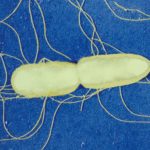Lien vers Pubmed [PMID] – 26944846
Appl. Environ. Microbiol. 2016 Mar;
It has been 30 years since the initial emergence and subsequent rapid global spread of multidrug-resistant S. Typhimurium DT104. Nonetheless, its origin and transmission route have never been revealed. We used whole genome sequence (WGS) and temporally structured sequence analysis within a Bayesian framework to reconstruct temporal and spatial phylogenetic trees and estimate the rate of mutation and divergence time of 315 S. Typhimurium DT104 isolates sampled from 1969 to 2012 from 21 countries on six continents. DT104 was estimated to have emerged initially as antimicrobial-susceptible in ∼1948 (95% credible interval, 1934 – 1962) and later became multidrug-resistant (MDR) DT104 in ∼1972 (95% CI 1972 – 1988) through horizontal transfer of the 13-kb SGI1 MDR region into already SGI1-containing susceptible strains. This was followed by multiple transmission events initially from central Europe and later between several European countries. An independent transmission occurred to the United States and another to Japan and from there likely to Taiwan and Canada. An independent acquisition of resistance genes took place in Thailand in ∼1975 (95% CI 1975-1990). In Denmark, WGS analysis provided evidence for transmission of the organism between herds of animals. Interestingly, the demographic history of Danish MDR DT104 provided evidence for the success of the program to eradicate Salmonella from pig herds in Denmark from 1996 to 2000. The results from this study refute several hypotheses on the evolution of DT104 and would suggest WGS may be useful in monitoring emerging clones and devising strategies for prevention of Salmonella infections.


